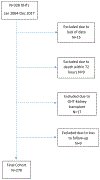Factors associated with neutropenia post heart transplantation
- PMID: 33982834
- PMCID: PMC8455412
- DOI: 10.1111/tid.13634
Factors associated with neutropenia post heart transplantation
Abstract
Background: Neutropenia is a serious complication following heart transplantation (OHT); however, risk factors for its development and its association with outcomes is not well described. We sought to study the prevalence of neutropenia, risk factors associated with its development, and its impact on infection, rejection, and survival.
Methods: A retrospective single-center analysis of adult OHT recipients from July 2004 to December 2017 was performed. Demographic, laboratory, medication, infection, rejection, and survival data were collected for 1 year post-OHT. Baseline laboratory measurements were collected within the 24 hours before OHT. Neutropenia was defined as absolute neutrophil count ≤1000 cells/mm3. Cox proportional hazards models explored associations with time to first neutropenia. Associations between neutropenia, analyzed as a time-dependent covariate, with secondary outcomes of time to infection, rejection, or death were also examined.
Results: Of 278 OHT recipients, 84 (30%) developed neutropenia at a median of 142 days (range 81-228) after transplant. Factors independently associated with increased risk of neutropenia included lower baseline WBC (HR 1.12; 95% CI 1.11-1.24), pre-OHT ventricular assist device (1.63; 1.00-2.66), high-risk CMV serostatus [donor positive, recipient negative] (1.86; 1.19-2.88), and having a previous CMV infection (4.07; 3.92-13.7).
Conclusions: Neutropenia is a fairly common occurrence after adult OHT. CMV infection was associated with subsequent neutropenia, however, no statistically significant differences in outcomes were found between neutropenic and non-neutropenic patients in this small study. It remains to be determined in future studies if medication changes in response to neutropenia would impact patient outcomes.
Keywords: CMV; heart transplant; infection; neutropenia.
© 2021 Wiley Periodicals LLC.
Conflict of interest statement
The other authors do not have any financial conflicts to disclose.
Figures
References
-
- Bodey GP, Buckley M, Sathe YS, Freireich EJ. Quantitative relationships between circulating leukocytes and infection in patients with acute leukemia. Ann Intern Med 1966;64(2):328–340. - PubMed
-
- Martin-Gandul C, Perez-Romero P, Gonzalez-Roncero FM et al.Clinical impact of neutropenia related with the preemptive therapy of CMV infection in solid organ transplant recipients. J Infect 2014;69(5):500–506. - PubMed
-
- Molina PE, Fernandez CJ, Seijo RS et al.Valganciclovir-induced leukopenia in liver transplant recipients: influence of concomitant use of mycophenolate mofetil. Transplant Proc 2009;41(3):1047–1049. - PubMed
-
- Ljungman P, Boeckh M, Hirsch HH et al.Definitions of Cytomegalovirus Infection and Disease in Transplant Patients for Use in Clinical Trials. Clin Infect Dis 2017;64(1):87–91. - PubMed
MeSH terms
Grants and funding
LinkOut - more resources
Full Text Sources
Other Literature Sources
Medical


